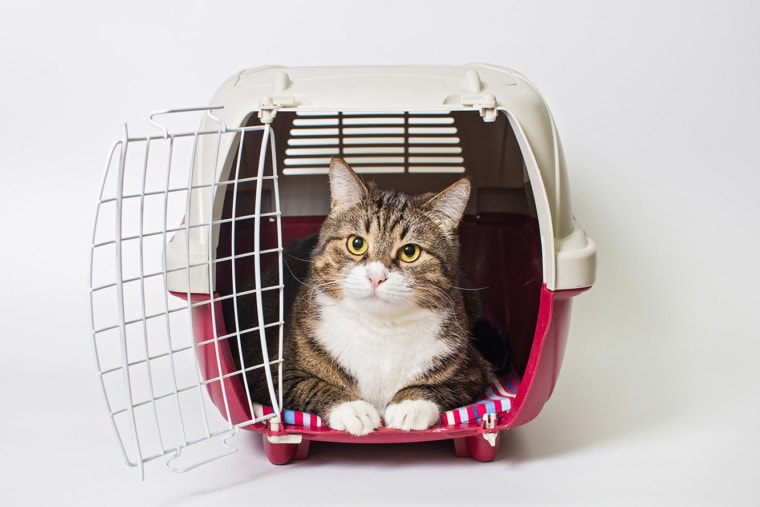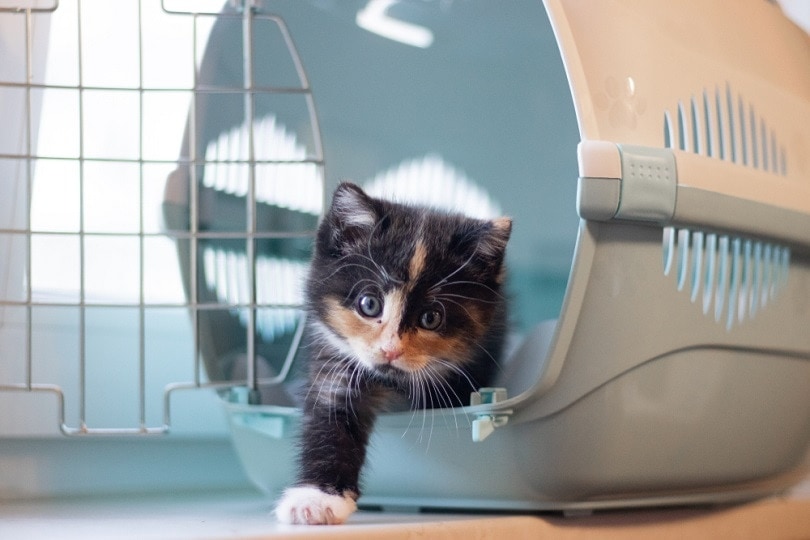
Traveling can be stressful for everyone. It can be even more stressful for felines, as they have no idea where they’re going or when they’ll get there. Life would be so much simpler if you could simply explain it to your cat! However, since this isn’t possible, you’ll have to resort to other methods instead.
Fortunately, there are many ways that you can calm a cat while they’re being transported in a cat carrier. Many of these do require a bit of prep before you leave the house, so it is typically a good idea to have a few items on hand in case you need to calm your cat later. If you know that your cat is going to be stressed out by the cat carrier, it is in your best interest to prepare appropriately.
The 10 Methods to Calm a Cat in a Cat Carrier
1. Play With Your Cat Before Walking Out the Door
An active, energized cat is likely to be even more stressed out when confined to a cat carrier. We recommend tiring your cat with a session of playtime before you leave the house. That way, your cat is worn out before you put them into the carrier. They may be more inclined to rest if they are already tired when they are placed inside.
Of course, this doesn’t always work, since a cat’s anxiety can often overrun their need to rest. However, it couldn’t hurt to try it, especially if your feline tends to be on the more active side.
2. Acclimate Them to the Carrier
If you have a bit of time before you plan on using the cat carrier, you can greatly relieve your cat’s anxiety by getting them used to their carrier beforehand. This can be done easily by simply leaving the cat carrier out and perhaps adding some blankets, bedding, and catnip to the carrier. Treat your cat whenever they go in the cat carrier, but don’t force them in it. You want them to get used to the carrier on their own without fear, which usually requires letting them do it on their own time.
The effectiveness of this method depends on how much time you have to prepare. You don’t want to force your cat into the cat carrier, so it can sometimes take days for your cat to start paying attention to the cat carrier on their own. For this reason, this method works best when you have 2 or 3 weeks to prepare before your trip at least. Longer is typically better.

3. Use Familiar Scents
Wherever you’re taking your cat, there are bound to be plenty of new and unusual scents. This alone can stress your cat out, especially if they aren’t used to leaving home. Consider adding blankets and pieces of clothing to the carrier that smell familiar to your feline. These can help keep your cat calm when they’re suddenly in a new place.
If you’re following the previous step, we recommend leaving the same blanket in the crate that has always been there. You want to keep things as normal for your cat as possible, so if they have had the chance to interact with their crate previously, just keep it the same.
4. Use Pheromones
There are many pheromones on the market that can naturally calm cats. These pheromones are artificial versions of the scent that mother cats produce to calm their kittens. Cats stay sensitive to these pheromones when they get older, so they can effectively calm down older cats too. These are undetectable by humans and don’t have any effect on us, so they can be used without potentially wrinkling your nose.
There are many potential options for delivering this scent to your feline. In a travel situation, collars and sprays are probably going to be your best bet. These things are easy to take with you and use as necessary. Your cat can simply use the collar the whole time they are traveling, or you can spray the inside of their crate with it.
There are many brands of pheromone collars, but they all work pretty much the same. After all, they are using the same pheromones. The major differences will be the structure of the collar itself, as well as things like whether the collar has a breakaway feature.
5. Ensure All Your Cat’s Needs Are Met
You should ensure that your cat has been fed and given enough to drink while traveling. Preferably, feed them before you travel. If you’re just going to someone’s house for an hour or so, feed them on their normal routine. For longer trips, you should have a pet water bottle handy for them to drink out of if necessary.
Being thirsty and not knowing when they’re going to drink next can be very stressful for cats. You should provide them with water regularly, before they start showing signs of stress or dehydration.
We also recommend avoiding feeding your cat right before you leave if they are known to experience car sickness. Often, being a little bit hungry is much better than feeling sick and potentially vomiting all over the carrier. Know your cat, and choose the option that works best for them.
6. Stay Nearby
Some cats will be calmed by their owner’s presence. Others could care less. Still, you should plan on staying nearby when your cat is being transported to ensure that they are staying calm and to proactively help them stay calm if they seem a bit anxious. Many cats may be stressed by spending time alone while also in a new place, so your presence may help them calm down.
Once again, this works on the idea that cats will prefer familiar things while they’re traveling, which includes you. It may not work so well if you have someone else stay with them, especially if that someone else isn’t someone they know very well.

7. Support the Carrier From the Bottom
Yes, carriers have handles. However, carrying a carrier by the handle often makes it sway and bump into things. This can stress your cat out and make them feel like they’re not being held solidly. You can instead carry the carrier from the bottom, which eliminates many of these problems.
You can’t do this with all carriers, especially if they are bulkier. However, if you can, this is the route we recommend. If you have yet to purchase a cat carrier, consider choosing one that you can easily carry from underneath.
Set your cat down whenever you have the opportunity, as this will also make them feel more secure. You want to limit the amount of time they’re actually spending in the air, as the swinging and up-and-down of your footfalls can stress them out. Make them feel as stable as possible by placing them on a solid surface whenever you can.
8. Don’t Rush
If you’re quickly trying to shove your cat into the carrier and get them into the car, your cat will often get even more stressed out by the quick pace. If you’re stressed about being late, then your cat may feed off of this energy. Make sure you have plenty of time on your schedule, and start leaving far before you actually need to. This will ensure that your feline will have time to adjust to the situation instead of being rushed off to the destination.
If you have enough time, you may want to consider letting your cat slowly adjust to each place before moving on to the next one. For instance, you may want to give them enough time to adjust to the car before you start it up and start moving. This won’t make some cats feel better, but it can make others feel better. It mostly just depends on your feline.
Rushing is never a good option, though. Take it slow and steady.

9. Stay in the Car
If you can, avoid going into the waiting room of a vet’s office with your cat. Call the front desk when you get there, and ask if they can simply let you know when a room is open. This allows you to completely skip the whole waiting room, which is often the location that is going to stress your feline out the most.
All the new cats and dogs can easily make your cat feel anxious, especially since they are stuck in a crate. If you do have to wait in the waiting room, we recommend covering your cat’s crate with a towel from home. It should be one that smells familiar, so don’t choose one that you just washed. This towel will help block out some of the scents and sights of the waiting room, which may help your cat stay calmer.
Cats usually need 5 to 10 minutes to take in their new surroundings, so if you’re switching locations constantly, they may be unable to relax. Stay in the same place as much as possible, especially if you’re going somewhere that is bound to have scary smells and sights, like the vet’s office.
10. Prep the Car Beforehand
Be sure to get the car ready for your cat before you get in it. Heat it or cool it to the correct temperature before you hop in with your feline. This will help prevent the cat from getting stressed due to the temperature change. Furthermore, the inside of a crate isn’t as ventilated as just sitting in a car, so the crate may not cool down at the same rate as the rest of the car.
Generally, any major changes can negatively affect your cat. Therefore, you should make your car’s environment match your home’s as much as possible. While you should plan on having plenty of familiar-smelling items in the crate, you may want to add a few to the car too.
Plan on playing soft music while you travel. Loud music can stress out your feline, especially if it starts to vibrate the car. Remember, your cat is in a crate, so it may pick up the vibrations more easily.

Final Thoughts
Traveling with your cat can be stressful, especially if your feline isn’t used to riding in the car. However, every cat is going to need to travel at some point. Whether it is to the vet or on a trip, keeping your cat calm in a crate often involves a lot of prep work. There isn’t much you can do to calm your cat in the moment unless you are prepared.
In general, you should try to make your cat’s carrier similar to their environment at home. This means adding objects that smell like your home to your cat’s carrier, as well as keeping the environment generally the same. It also means blocking out unfamiliar sights and sounds, which can be done by covering the crate with a blanket.
We hope that the suggestions in this article will help you keep your cat a bit calmer during their travels. In all likelihood, your cat won’t simply lie down and rest while you’re traveling. Some stress is to be expected. However, your goal should be to keep your cat as calm as possible, which often means taking action on many of the tips included in this article.
Related Reads:
- How to Calm Your Cat While on a Plane: Effective Tips
- Why Do Cats Hate Car Rides? Reasons & Solutions
- Can You Put Your Cat in a Crate at Night? Vet-Reviewed Facts & FAQ
Featured Image Credit: Okssi, Shutterstock






